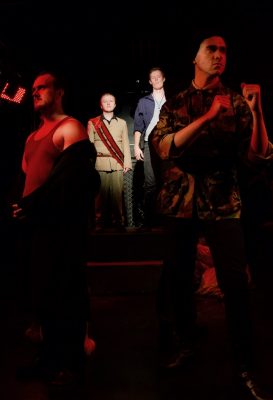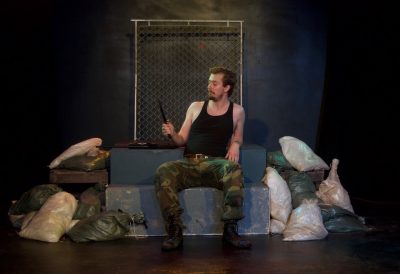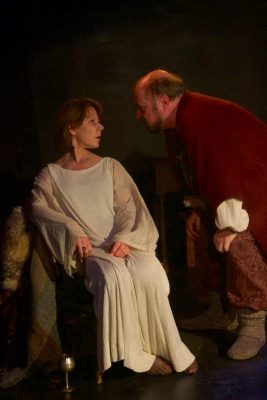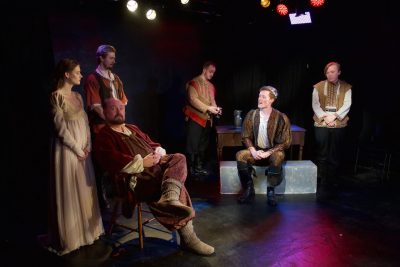Shakespeare’s “King John” sets the scene for the first full-length season of 4615 Theatre Company, in progress now with the Bard’s lesser-known history play and James Goldman’s “The Lion in Winter”—both on stage through Aug. 5 at Silver Spring’s Highwood Theatre. “We were looking for the Shakespeare play to anchor the season,” said Jordan Friend, founder and director. “I picked ‘King John’ for reasons that have become less important because I started with the political approach. … The Shakespeare play for the modern age is ‘King John’ because it’s about political absurdity and the notion of rule as a cult of personality.”

Then he found the deeper meaning in it. “Once I started studying the script myself, I came to better understand that the story is about a child whose father didn’t love him enough. All of John’s decisions in the play are about proving himself somehow to his parents,” Friend said. “So that came to my forefront: This can direct the rest of the season as being about parents and their children, being about descendants and the notion especially of being children of legend, children who are living in the shadow of a myth in some way.”
Because 4615 Theatre Company has been about “the notion of exploring storytelling as a form, and exploring narrative as a form” since its inception in summer 2013, Friend and his core group of artists conceived a novel debut for their first full-length season. “This summer, we’re doing two plays that are about the same family, but were written 400 years apart, and we’re saying, how do these playwrights separated by four centuries talk to each other and address the same subject in a different way and tell this story in a different way?” he said. “We’re always going to do things that have to do with time passing, locations changing, or look at how language affects storytelling in some way or movement affects storytelling.”
Plays are full-length, two-hour productions staged at distinct times. They work separately, Friend explained, but seeing both gives audience members a richer experience.
A cast of 14 rehearsed for “five intensive weeks” with seven of the actors appearing in both shows. “We always do a shorter rehearsal process because it’s meant to be a small theater, but also because some of it is honoring the older (Elizabethan) rehearsal practices a little bit—they would not have had these incredibly long gestation periods. We want a certain spontaneity, a certain aliveness, something that comes from something that the actors have a little bit more of a grip on and isn’t choreographed necessarily within an inch of its life,” Friend explained.

That said, a great deal of thought went into the staging of the two distinct plays in a 20-by-40-foot black box theater. “It creates a lot of really exciting challenges,” Friend said of the intimate space, “because ‘Lion in Winter’ is a seven-person play and our play space is like 12-by-18 feet, but ‘King John’ is a war play and half the play is battle sequences and it’s about two armies meeting on the field, having a standoff for most of the play.”
Friend said that this challenge fostered creativity. And perhaps most importantly, “taking a show that on the surface would demand high technical prowess and constraining it to a space with unusual limitations makes us examine what is vital about that story and how we’re telling it. Our frame defines our composition, our restrictions are our opportunities, and that mentality has really driven how we get creative.”
The company decided to create two separate sets. “There are a few props that carry over—the crown is the same—but we made the decision (to use two sets) that was creatively very exciting and budgetarily very absurd,” Friend said.
“With ‘Lion in Winter,’ which is set in 1183, we’re staying loyal to the period and we’re doing period dress and period props,” he said. “But with ‘King John,’ an Elizabethan troupe would not have stayed loyal to period. They would have worn Elizabethan garb. … They would have used the resources that they had. So, we kind of took that concept and went a little extreme with it and ‘King John’ is in modern military dress—it’s camo and assault rifles and explosions going off and rock music. … The set for ‘Lion’ is very minimalist; it’s wood furniture and goblets and tapestries, whereas the set for ‘King John’ is a barricade with chain-link fences.”
The theater is changed over between shows, which Friend acknowledged is “pretty crazy.”

Also crazy in a mind-blowing way are the fight scenes in “King John.” The play uses “non-literal forms of visual storytelling,” Friend explained. “You don’t need to necessarily show what the thing is; you show what it’s meant to be and the audience fills in the blanks really well.”
Lighting, sound and space are used to suggest the sensory experience of the battlefield, and fight sequences “are very unique,” Friend said. “Rather than just hundreds of extras hacking and slashing as they might be at Wolf Trap and the Kennedy Center, we did something different. … They’re like dances in a way … with a lot of rhythmic movement.
“I have an incredible movement team. I’ve done the fight choreography, but I’ve also got a movement coach that did combat training for all the actors, and she also melded with my fight choreo to make it closer to military combat and she tweaked things and added things. … It’s not your normal Shakespeare production.”
Which is fitting for a theater company that since its first production, “The Duchess of Malfi” in eight rooms of a suburban home, has been an outlier.
“It was total insanity,” Friend said of “Malfi” that earned the fledgling company a positive review in The Washington Post. “It’s not the kind of thing we’d ever do now that we’re a professional company because A) you can’t get a major audience into it, and B) it’s like too out there, but while we were kind of young and playing and kind of working in an unconstrained environment, that’s what we came up with, and we continued to do found-space work for a while in backyards, church basements and classrooms, and now we have a theater that we work in and rent.”
For several years, Friend’s core group of artists and actors came together during college summer and winter breaks, staging productions like Martin McDonah’s “The Pillowman” and Eugène Ionesco’s “Exit the King.” Then last year, after graduating from Ithaca College, Friend decided to take the company in a more professional direction.

“A lot of the people who are part of the core team are people who have just graduated college and are looking to getting their footing in the area, and rather than all of us being without a paddle looking, we’ve banded together and said this is going to be the hub where we produce our work and where we show our creativity because it is so easy to drift around for your first few years. (It’s) just like (an intern) hoping to run coffee for someone and we’re kind of cutting in line and saying, you know what, if we all pull together we can raise enough money to do the work we want to do rather than waiting for the chance to do it,” he explained. “And at the same time, all of us also have our fingers in other pies so we’re bringing in experience from other places.”
One of those people is Susannah Clark, dramaturg for the current 4615 shows and artistic fellow at the D.C.’s Shakespeare Theatre Company. Clark has been with 4615 since the beginning, has held many roles, including actor, managing director and literary director, and has known Friend since the two were in high school at Georgetown Day. As Friend was getting this season up and running, Clark was in her senior year at Wesleyan and was his sounding board and collaborator.
“4615 has come a long way,” Clark said, “and we’re figuring out what works for us.” But, she stressed, “we don’t want to compromise. We’re still a group of young, scrappy, poor kids trying to do the most that we can with limiting circumstances.”
This season is the first with many new company members, she said, and that has pushed 4615 to a new level of professionalism. “Most actors haven’t done anything like this,” she added, referring to bringing two creatively produced plays to stage simultaneously with only five weeks of rehearsal.

Though a non-union theater, 4615’s actors are paid, Friend said. “Right now, it’s enough to cover the expenses that come from doing it and the time you’ve lost.”
Clark has worked largely as a history consultant for this season’s debut productions. “I did quite a bit of research into ‘John,’” she said. “Shakespeare took some creative liberties, and he compressed 40 or 50 years of history into a few months. I talked to actors about time and place (at rehearsals) and answered their questions.”
And what is her sense of how the two playwrights talk to each other across four centuries? “Well, it’s really an 800-year evolution of the understanding of that history,” she said. “Shakespeare wrote his play like 400 years after these events happened.”
4615 Theatre Company’s Plantagenet Repertory presents “King John” and “The Lion in Winter” through Aug. 5 at the Highwood Theatre, 914 Silver Spring Ave., Silver Spring. “King John” shows are at 8 p.m. July 28, Aug. 3 and Aug. 5, and 2 p.m. July 29. “The Lion in Winter” shows start at 8 p.m. July 27, 29 and Aug. 4, and 2 p.m. July 30 and Aug. 5. Tickets are $16. Visit www.4615theatre.com or call 301-928-2738. Look for Sophocles’ “Electra” Oct. 20 through Nov. 4, and Saviana Stanescu’s “Waxing West” Jan. 19 through Feb. 10.